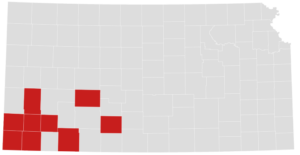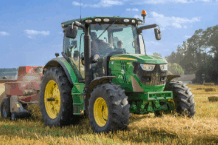More than 30 years ago, a group of southwest Kansas counties tried to secede and form their own state called West Kansas. It’s largely forgotten now, but the political divisions that caused it remain.
Secession movements in places like eastern Oregon continue to make headlines today, but back in the 1990s, parts of western Kansas made an effort to secede that previewed the political divisions that still cause people in the U.S. to consider cutting ties from their governments.
In Kansas, the effort involving nine southwest Kansas counties all started with a disagreement over school funding policies.
After people in western Kansas felt a new school funding law adversely affected rural schools, some residents of the nine counties were so upset that they petitioned to leave the state. They proposed a new state called West Kansas.
In the heart of one of those counties, tucked behind endless rows of corn and milo, Sharon Concannon takes a trip down memory lane, thumbing through a book of newspaper clippings and documents from the time.
The navy blue book’s cover exclaims, “Toto, we’re not in Kansas anymore” in large white letters.
The laminated book documents the reactions to a secession movement that grew out of the region 30 years ago.
Concannon remembers how it unfolded.
“They went about getting petitions signed to make our own state,” Concannon said.
As she flips through the pages, she chuckles at some of the headlines. They remind her of her late husband, Don, who started this movement.
“He was an attorney, and he felt that … we’re just kind of no man’s land,” Concannon said. “We don’t feel like we’re ever heard.”
Don has since passed away, like many of the others originally involved in the movement to form West Kansas.
The push for ‘West Kansas’
Supporters of the idea were so serious that they gathered in 1992 in Ulysses, Kansas, and drew up state borders. They decided what should be the West Kansas state bird, the pheasant, and the state flower, the yucca.
Pete McCormick grew up 30 minutes from Ulysses in Lakin, just outside of Garden City. He was studying cultural geography at the University of Kansas and wrote his thesis on this topic in 1995. He said there was a clear reason these Kansans were upset
“The state redid its school finance laws, and basically it was trying to equalize things across the board,” McCormick said.
But it didn’t seem like equalization to many in the western part of the state.
Southwest Kansas was enjoying economic stability because of the growth of natural gas and irrigated grain, without a significant tax burden. Schools in this rural region were spending north of $5,000 per student, but this new law would cap that at just $3,600.
With the 1992 school finance formula, eastern Kansas received significant tax relief, and southwest Kansas saw an increase in tax rates.
This further stressed the already existing divide between the more populous eastern parts of Kansas and more rural western Kansas.
“I remember there was a sign on the motel in Lakin, and it said ‘To hell with Topeka, let’s secede,’” McCormick said.
Cultural divisions
Through the lens of cultural geography, McCormick can see the distinctions between the two halves of Kansas.
The different landscapes have influenced the cultures, and the different cultures have simultaneously impacted the landscapes.
Looking at western Kansas, patterns of circles and squares show the impact of farming, and how the rural towns have built lives in an area with plentiful farmland and mineral resources, but not a whole lot else. Seemingly every other car has a license plate proclaiming “eat beef” as a reminder of how agribusiness and beef processing are the centers of this region’s economy.
Eastern Kansas is less flat, receives more rain and has urban centers that are more industrialized, similar to other midwestern states.
“Those cultural distinctions are there, and so when you had something as shocking as this tax reform, immediately everybody was like, ‘alright, that’s it,’” McCormick said.
Counties that voted to secede and create “West Kansas” in 1992
Stanton, Morton, Kearny, Grant, Stevens, Haskell, Hodgeman, Meade and Kiowa.
Results from a public poll showed in seven of the eventual nine southwest Kansas counties, a whopping 85% of the residents who answered the polls were interested in secession.
Joe Thompson, Stevens County commissioner, said the movement now is largely forgotten.
“There may be some folks hanging on to that, but it’s been years since I’ve seen or heard anything about it,” Thompson said.
But a major aspect of the secession movement was natural resources and education, issues that linger today. Since the movement, resources have continued to dwindle. Oil in Kansas has gone down ever since, and so has groundwater for irrigated grain.
Looking at the parallels today
Donald Haider-Markel, political scientist at the University of Kansas, said these kinds of secession attempts have become more common in rural areas over the years.
“This is what happens when a rural region of a state feels neglected and creates an ‘us versus them’ mentality,” Haider-Markel said.
And those feelings can still linger today. The West Kansas movement took place when Kansas had its first Democratic woman for governor, who was widely disliked by the larger conservative western constituents.
As rural schools continue to consolidate, the way taxes flow through the region remains a big contention.
Many of the counties involved in the movement saw their populations peak before the year 2000.
And just as they once feared, this region of Kansas has the hardest time retaining teachers today.
Haider-Markel also pointed out that the movement may have been a precursor to our identity politics in the country today, as factions fear loss of control. The West Kansas group was able to garner overwhelming support by leveraging dissatisfaction with state leaders and dissociation from the rest of the state. That’s still seen today in far-right groups that resist the federal government.
“You could find some roots of what you see today in the Republican Party in Kansas, really going back to the 1990s. Where there’s sort of a super far-right portion of the party,” Haider-Markel said.
In the end, the movement was thoroughly squashed after the state attorney general said it was unconstitutional and called it an exercise in futility. A couple years later, multiple rural school districts filed lawsuits against the school funding law, but the law was upheld by the Kansas Supreme Court.
Back in her office in Hugoton, Sharon Concannon said her husband Don, an attorney, knew this movement was doomed, but did it more as a stunt to grab lawmakers’ attention. Ultimately, it worked.
“I don’t think anybody ever really believed it could happen, but everyone was absolutely amazed at the support we got,” Concannon said. “He was just finding a way to get them to listen to us out here.”
Calen Moore covers western Kansas for High Plains Public Radio and the Kansas News Service. You can email him at cmoore@hppr.org.
The Kansas News Service is a collaboration of KCUR, Kansas Public Radio, KMUW and High Plains Public Radio focused on health, the social determinants of health and their connection to public policy. ksnewsservice.org.



